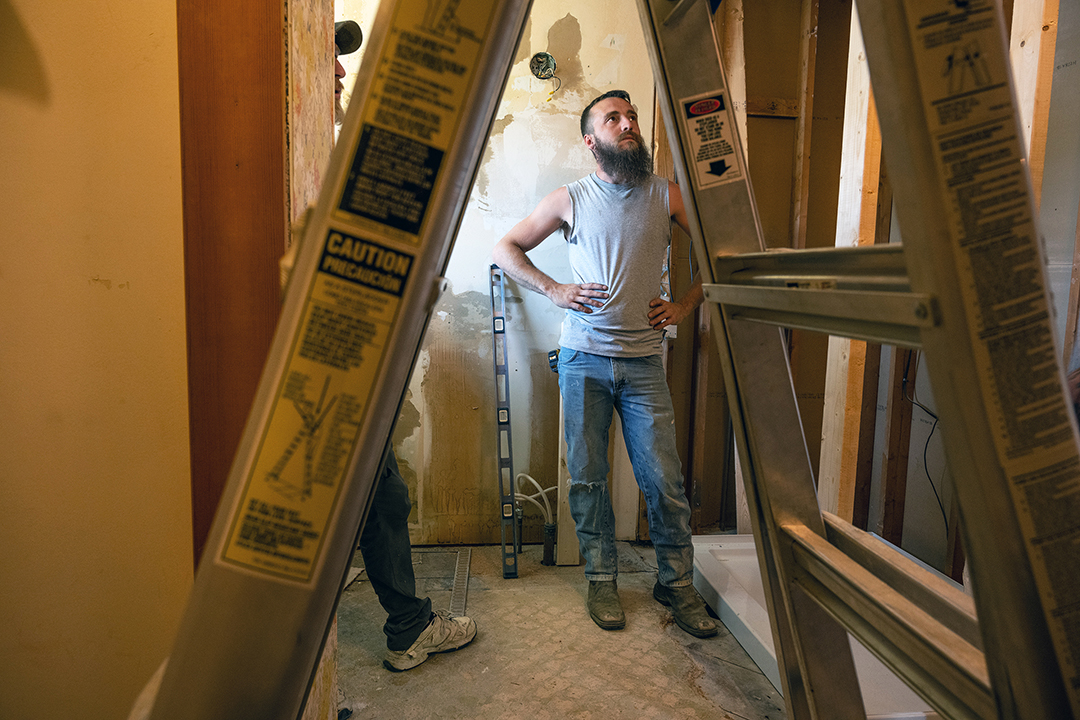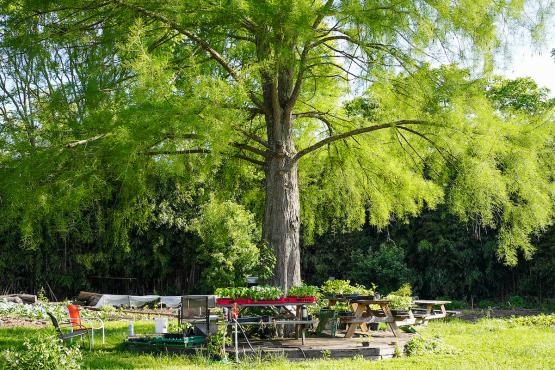Bryan Darst and two other workers are busy framing a new shower in a home bathroom in The Plains, Ohio. The three men are full-time employees of Community Renovations and Repairs, a social enterprise of Habitat for Humanity of Southeast Ohio that provides affordable home repairs to help veterans and elderly and disabled adults stay in their homes.
There is more than meets the eye at this renovation site—what’s happening here is a win-win-win cycle of virtue. Darst has been in addiction recovery for years and now serves as a peer mentor for those early in their recovery journey. The house he’s working on serves as a Level II recovery residence for those coming out of addiction. And eventual profits from the CR&R will go to Habitat’s mission to provide affordable housing for those in need.
“That’s kind of the purpose as we grow, is to help grow people, not just grow this enterprise,” Darst says.
Like all social enterprises, CR&R is a for-profit business that focuses primarily on a social motive, in contrast to the profit motive of most traditional businesses. An oft-quoted mantra of the social enterprise world is “people, planet, profit”— meaning that the social and environmental goals are just as important as financial goals. Launched in 2022, CR&R has already broken even and is on track to beat its own projected timeline to reach profitability, thereby financially supporting Habitat as well.
This scenario likely couldn’t have played out without the support of The Sugar Bush Foundation, a supporting organization to the Ohio University Foundation. Sugar Bush’s mission is to support sustainable economic development projects that restore the environment or strengthen local food systems. It began when the foundation funded Habitat’s Zanesville ReStore, which opened in 2015.
“The ReStore is a social enterprise, so we were familiar with a social enterprise,” says Ken Oehlers, executive director of Habitat for Humanity of Southeast Ohio. These Habitat retail stores sell leftover, donated construction material that might otherwise end up in the landfill. Oehlers approached Sugar Bush again in 2017, which led to a study through Ohio University’s Voinovich School of Leadership and Public Service. (Sugar Bush-funded projects must involve both Ohio University and the community.) That study was the beginning of the process that led to CR&R.
All told, Sugar Bush has helped incubate or grow 16 social enterprises in Southeast Ohio since 2009, including a curbside recycling program in Chillicothe, an impact measurement service that calculates the value of social impacts, and a farm-to-OHIO working group that connects regional farmers to the buying power of Ohio University.
“We firmly believe that it takes community to build community,” Oehlers says. “We look for those types of partners. Sugar Bush is that type of partner where it’s not about giving you a check and [saying] ‘See you next year.’ It’s about walking the journey, celebrating together not only the successes, but also the challenges.”
From Trash to Treasure
Sugar Bush takes an asset-based approach to problem-solving. “How do you look at waste as an asset?” asks Hylie Voss, president of The Sugar Bush Foundation. “What can you get out of the waste stream that is of value? By removing it from the waste stream and reselling it, repurposing it, upcycling it, you create a job.”
A million-dollar answer to that question comes in the form of True Pigments, LLC, a social enterprise of local nonprofit Rural Action. True Pigments recently bought the largest acid mine drainage seep in the state of Ohio; there, it’s building a large-scale production facility to clean the Sunday Creek watershed by extracting iron oxide from the drainage and then processing it into pigments for use in products like paint and bricks.
“We will be able to produce about 2.1 million pounds per year of iron oxide pigment,” says Michelle Shively MacIver, director of project development for True Pigments. “A conservative estimate is about $1.5 million in sales each year.”
The projected profits will support Rural Action’s watershed programming, provide local jobs and help “green” the iron oxide industry through carbon emission reduction, as most of the raw material used in the United States today is imported.
Once again, this highly impactful project may not have happened without support from Sugar Bush. Back when the budding program was a partnership between Rural Action and Ohio University—the project is made possible through proprietary research by OHIO faculty members Guy Riefler (civil and environmental engineering) and John Sabraw (painting and drawing)—scaling it was the big challenge. Sugar Bush stepped in to provide funding for a pilot project on Sunday Creek beginning in 2016.
“Without the pilot scale, I don’t think we’d be where we are today,” says Shively MacIver. “That was a pivotal moment. We went from Guy being pretty sure the technology worked—in Rubbermaid tubs in his lab—to being able to build something on-site to show it was working. That was a major milestone for us. … There’s no way we could have ever jumped from lab-scale to full-scale. There had to be that pilot.”
Sugar Bush funding also provided credibility in the eyes of other funders. Since the pilot project, True Pigments has raised some $3.5 million in funding from the Ohio Department of Natural Resources and the federal Office of Surface Mining, which is how the full-scale facility will be built. It is expected to begin selling pigment by 2025.
Quadruple Bottom Line
Southeast Ohio loves its festivals. Thousands of people have milled about the grounds of the Ohio Pawpaw Festival or the Nelsonville Music Festival over the years, enjoying the performances and vendors. What many don’t realize, though, is that these are zero-waste events, so called for their goal of diverting more than 90 percent of waste from the landfill through recycling and composting.
Zero Waste Event Productions, a social enterprise that also grew from Rural Action, works with outdoor festivals to plan and execute zero-waste events. ZWEP provides materials (bins, signage), human resources (staff, volunteers) and post-event cleanup. It’s another win-win-win scenario, where what is often considered a problem—waste—is turned into a profitable business model that employs people while diverting waste from the landfill and helping festivals attain zero-waste status.
ZWEP employs two people full-time, plus seasonal employees, and works with dozens of festivals throughout the Midwest. It is a social enterprise borne out of the Appalachia Ohio Zero Waste Initiative, which has been funded by Sugar Bush since 2010.
Paul Patton, Rural Action’s chief innovation officer, likes to add a fourth P to the “people, planet, profit” mantra: purpose. The nature of the group’s work with social enterprises, he says, “has an opportunity to provide us meaningful experiences in our employment—purpose—in our lives.”
Learn about Sugar Bush-supported organizations.
Mary Reed is a member of The Sugar Board Foundation board.






